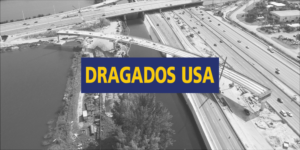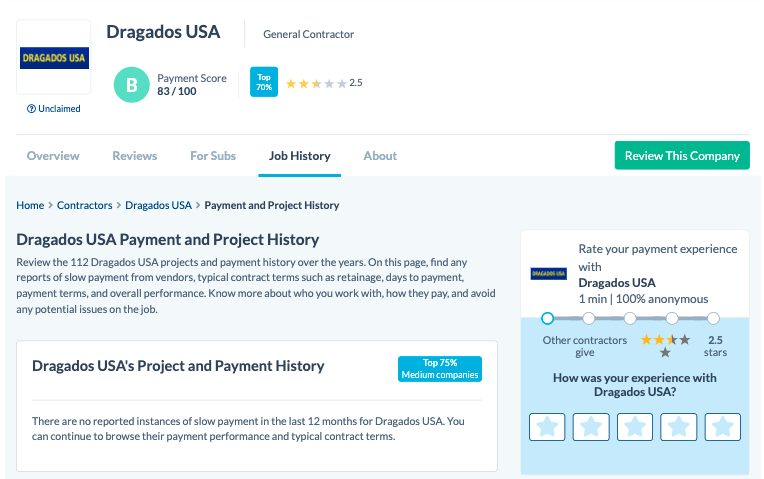
Before you start subcontracting for Dragados or any general contractor, you need to do as much research as possible to ensure the general contractor isn’t a credit risk. This subcontractor guide to working with Dragados will help you identify the financial risks — and teach you how to protect your payments on any project with the GC.
Dragados company history
Dragados’ history is relatively short and sweet compared to some long-standing construction companies: Dragados USA is a subsidiary of Dragados — a construction company formed during WWII to dredge the Port of Tarifa. Both of those companies fall under the ACS Group, a Spanish engineering and construction company made up of smaller affiliates.
Dragados’ US-based history began in 2005 when ACS Group opened an office in NY. Shortly thereafter, the company began specializing in transportation, hydraulic, and underground projects. On ENR’s 2020 Top 400 Contractors, Dragados ranks number 28. That’s up one spot from 2019.
Dragados has offices in New York City, Houston, both Pleasanton and Cosa Mesa, California, and Coral Gables, Florida.
To carry out its projects, Dragados partners with construction companies it considers as affiliates (though they also fall under the ACS Group):
Dragados’s Current US projects include:
- Southern Ohio Veterans Memorial Highway P3, Ohio
- High-Speed Rail project, California
- SH-181 Harbor Bridge Replacement, Corpus Cristi, Texas
- SH-288 Toll Lanes P3, Houston, Texas
- Alaskan Way Viaduct SR99 Bored Tunnell Alternative, Washington
Dragados & the California High Speed Rail
Dragados is part of Dragados/Flatiron JV, a joint venture with Flatiron operating as the general contractors on Package 2-3 of the California High Speed Rail project.
The payment bond on this portion of the project, underwritten by a group of surety companies, is worth nearly $1.4 billion.
Learn more about this project, including contact and payment bond information, on the Subcontractor Guide to the California High Speed Rail project.
Before working with Dragados
Before you sign a contract, it’s important to prequalify the general contractor — even if you have worked on a project with them before.
General contractors make you jump through hoops for them to prequalify you — you should do some digging to ensure they are a good partner for you as well.
If you’re uncertain about how to prequalify a general contractor, use the following steps as a road map:
- Dig into the company’s payment history
- Review the company’s credit history
- Read subcontractor reviews
- Check out a sample subcontract, if available
- Familiarize yourself with the company’s payment process
Through the prequalification process, you’re likely to uncover a few red flags that might have you concerned. It’s important to understand that’s a near-universal fact. The construction industry is a tricky business, and even a newer company like Dragados is bound to have a few rough patches in its past.
Instead of writing a company off altogether because you found a few glaring instances, reach out and speak to them. Ask questions about your concerns. When a GC is upfront about an issue and explains their position honestly, that matters. In fact, it might tell you more about what it’s like to work with them than a bad review from an upset sub on the internet.
Dragados payment profile
Dragados’s Contractor Payment Profile shows a payment score of 83 out of 100, giving it a B rating. That’s a commendable score for a company that ranks as well as it does with ENR.

For reference, this contractor payment score is a result of collecting data about Dragados’ payment practices and comparing it against the scores of thousands of other contractors. These scores are a helpful benchmark that subcontractors can use to compare general contractors, allowing them to make a more informed decision.
Learn more about how a contractor’s scores are calculated here.
Payment disputes & subcontractor reviews
Another helpful window into seeing how a general contractor treats its subs is by looking at recent payment disputes and subcontractor reviews. Disputes can include slow payment reports, liens threatened, or liens filed against projects managed by the company. Almost all contractors have a dispute or two to their name.
Dragados’ job history is free from any payment disputes in the past 12 months, though they did run into some payment issues on projects in the past few years. In 2020, 88% of their projects had no reported payment incidents, up from 78% in 2019.
Keep in mind, however, that Dragados’ portfolio includes a number of public works projects. Because a lien claim is not available on government jobs, payment disputes on public projects involve bond claims, which often do not appear in public records.
At the time of writing, only one subcontractor has provided a review of Dragados, with a word of warning:
“Use caution. Extremely late paying. 4 months and counting with little interest in paying large invoices. Small bills of a few hundred dollars get paid in a timely manner. Invoices for tens of thousands take many months or not at all at this writing.”
Getting paid with Dragados
Everyone knows that the construction industry can be volatile, so even companies with shining payment histories might have an issue from time to time. For that reason, you should know as much as possible about a general contractor’s payment policies before you start working with them.
Before work starts
Most general contractors will have some required documents that you’ll have to supply before you can start working on a project. They often include:
- Your W-9
- The signed subcontract
- Insurance certificates
- Any bonding information related to the project
The project manager is likely to be the point of contact on these. They’ll let you know which documents the company needs before you can get to work.
First Payments
Large general contractors have a lot going on, and they tend to like standardized methods. They can achieve that level of simplicity with industry-standard AIA billing, including G702 payment applications, and G703 continuation sheets.
A word to the wise: Be sure to ask the project manager when payments are due. Most likely, they’ll be due on the 1st, 5th, 15th, or 20th, but be sure to ask so you don’t miss a payment window.
Retainage
The amount of retainage that Dragados withholds will depend on the contract and prompt payment laws in the state where the project is located. According to other subcontractors who have worked for the GC, Dragados typically withholds 5% retainage on projects in California.
Progress payments
Large GCs work on large projects, and they take years to complete. You can’t wait that long for payment. Whether your company is on-site for the duration of the project or just a few months, progress payments will keep the cash flowing.
While you’re sending in your payment application, be sure to include an updated schedule of values to streamline the process.
Project closeout
General contractors each have their own methods or processes they use for close-out, but they usually include:
- Punch lists
- Certificates of occupancy
- Certificates of substantial completion
- Lien waivers
- Inspection certificates
But beware that project close-out can be a tricky time. While you’re focused on final payments and retainage, it’s entirely possible that you might sign something you shouldn’t. Be sure to watch for lien waivers because if you sign one before you’ve been paid for the work, you could be throwing away your right to a mechanics lien.
3 tips to getting paid on every construction project
Delays and disputes are commonplace in construction, and they can arise from any corner of a job — payment problems are not always the fault of the general contractor.
The following three tips will help protect your cash flow on any project with Dragados.
1. Send preliminary notices
Plain and simple: start sending preliminary notices on all of your projects. Many states require GC, subs, and suppliers to send these documents in order to protect their lien rights. That makes this one document crucial. Consider it the foundation of your payment protection plan.
Even if your project is in a state that doesn’t require you to send preliminary notices, send them anyway. They serve as a professional introduction between your company and the folks cutting checks — don’t you want those people to remember your name?
2. Focus on visibility
Sometimes a payment dispute isn’t so much a dispute as it is an issue of visibility. If your invoice is at the bottom of the pile, sending visibility documents like invoice reminders, notices of intent to lien, and demand letters could bring them back to the top.
3. Make lien rights a priority
The entire point of taking larger projects is generally money and growth. If you want to ensure you have both, you need to protect your lien rights.
When a payment dispute occurs, filing a mechanics lien is the fastest way to resolve it. Because these tools are so powerful, states have stringent requirements contractors must meet to use them. Be sure that you pay attention to the rules in your project’s state so you can make preserving your rights a priority.
